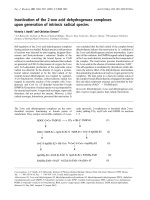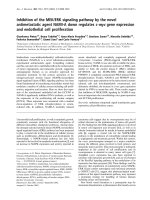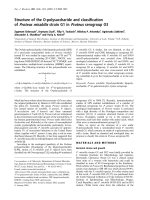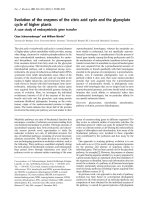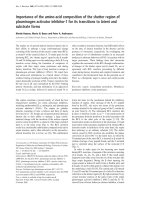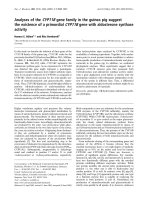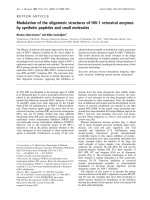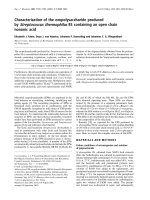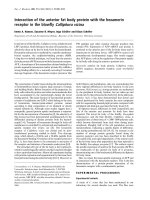Báo cáo y học: "Atrophy of the brachialis muscle after a displaced clavicle fracture in an Ironman triathlete: case report" docx
Bạn đang xem bản rút gọn của tài liệu. Xem và tải ngay bản đầy đủ của tài liệu tại đây (829.26 KB, 4 trang )
CAS E REP O R T Open Access
Atrophy of the brachialis muscle after a
displaced clavicle fracture in an Ironman
triathlete: case report
Christoph Alexander Rüst
1*
, Beat Knechtle
1,2
, Patrizia Knechtle
2
and Thomas Rosemann
1
Abstract
Clavicle fractures are frequent injuries in athletes and midshaft clavicle fractures in particular are well-known injuries in
Ironman triathletes. In 2000, Auzou et al. described the mechanism leading to an isolated truncular paralysis of the
musculocutaneous nerve after a shoulder trauma. It is well-known that nerve palsies can lead to an atrophy of the
associated muscle if they persist for months or even longer. In this case report we describe a new case of an Ironman
triathlete suffering from a persistent isolated atrophy of the brachialis muscle. The atrophy occurred following a
displaced midshaft clavicle fracture acquiring while falling off his bike after hitting a duck during a competition.
Keywords: Displaced clavicle fracture, Ironman triathlete, muscular-atrophy, brachialis muscle, brachial plexus
Background
Lesions of the brachial plex us are known to occur after
displaced clavicle fractures. The most common way to
get a lesion of the brachial plexus is a high-energy trauma
leading to traction injuries [1,2], whereas lesions o f the
medial and the posterior cord have been reported most
frequently [3,4]. A bone fragment from a displaced clavi-
cle fracture is described in only 1% of the cases as the
causative factor [4]. In this report we describe th e case of
a lesion of both, the musculocutaneous and axillar nerve
with subsequent atrophy of the brachialis muscle.
Regard ing the anat omy, the axillar nerve originates from
the posterior cord, whereas the musculocutaneous nerve
originates from the lateral cord, which is not known to
be affected by such injuries very often. The additional
fact that a lesion of the brachial plexus occurred a certain
time a fter a displaced midshaft fracture of the clavicle
makes the case even more interesting and remarkable.
Case presentation
In the las t two kilometres of the cycling split in an Iron-
mantriathlonahighlytrainedathletehitaduckinthe
street and fell on his right side. He felt a sharp pain in his
right shoulder and had to stop the race. Due to a previous
clavicular fracture on his left side, the rider was highly sus-
picious of having sustained a similar injury. He returned
back home and put on his old figure-of-eigh t dressing
from the last fracture, without consulting a physician. He
continued his training of indoor cycling and running and
had no problems. Two weeks later b efore starting his
swim training he continued to feel pain in his right
shoulder, radiating into the radial side of the forearm and
into the fingers. The clavicular head of the deltoid muscle
showed a decrease d sensation to light touch. An X-ray
revealed a displaced fracture of the right clavicle (see
Figure 1Panel A) and the athlete was advised to get this
fracture treated surgically. A pre-operative CT scan was
performed to help determine surgical fixation choices (see
Figure 1Pane l B). Since the athlete is a family physician
and thus knows the available options, he asked for an
intramedullary nail and the surgeon agreed. Post-surgi-
cally, the pain disappeared initially, but it returned after a
few days. An MRI scan showed a small and, according to
the surgeon, negligible hematoma around the plexus
which was, according to the neurologist’s expert opinion,
the reason for the pain. Additionally, also the pressure
impinging on the nerves during the accident occurrence
could lead to a delayed onset of pain. Clinical and neuro-
physiological examination revealed a decreased sensation
to light touch in the service area of the musculocutaneus
* Correspondence:
1
Institute of General Practice and Health Services Research, University of
Zurich, Pestalozzistrasse 24, CH-8091 Zurich, Switzerland
Full list of author information is available at the end of the article
Rüst et al. Journal of Brachial Plexus and Peripheral Nerve Injury 2011, 6:7
/>JOURNAL OF BRACHIAL PLEXUS AND
PERIPHERAL NERVE INJURY
© 2011 Rüst et al; licensee BioMed Central Ltd. This is an Open Acces s article distributed under the terms of the Creative Commons
Attribution Licens e (http://creativec ommo ns.org/licenses/by/2.0), which permits unrestricted use, distribution, and reproduction in
any medium, provided the original work is properly cited.
nerve leading to the working hypothesis of a lesion of the
musculocutan eus nerve. The neurologist’ s assessment
showed that there were no signs of atrophy. With pregaba-
lin - an antiepileptic drug which can be used for the treat-
ment of neuropathic pain - (LYRICA
®
, Pfizer AG, Zurich,
Switzerland), the patient was free of pain and continued
training. Four months after the operation the radiological
examination was repeated (see Figure 1Panel C and D)
and the nail was removed. In the meantime the pain was
gone under the treatment with pregabalin a nd did n ot
reoccur after stopping the medication, thus an intraopera-
tive exploration of the nerves or a neurolysis was waived.
Two months after removing the nail, at the start of the
outdoor swimming season, the athlete realized he had a
hollow i n his right upper arm at the place where the bra-
chialis muscle normally is localized. Nine months after the
accident the hollow was still present (see Figure 2Panel A
to D) as well as a decrease d sensation on the clavicular
head of the deltoid muscle. Normal sensation returned to
the radial forearm over the sensory distribution of the lat-
eral anteb rachial cutaneous nerve. However, the atrophy
of the muscle remained unchanged. During all this time,
the athlete suffered no decrease in muscular strength and
continued training. One year after the accident, he won
two long-distance triathlons in a row.
Discussion
Nine months after the accid ent the athlete shows a per-
sisting atrophy of the br achialis muscle and a decreased
Figure 1 X-Ray and 3D reconstruction of the clavicle before and after operation. Panels A-D show pre and post operational images of the
injured clavicle. A: X-ray from the displaced fracture two weeks after the accident. The black arrows indicate the two main fragments of the
clavicle; the white arrows mark two additional fragments almost perpendicular to the clavicle main fragments heading towards the brachial
plexus. The numbers indicate the approximate length of the fragments in cm. B: 3D reconstruction of a computer tomography done the day
before the operation. The arrows indicate the fragments heading towards the brachial plexus. C: X-ray made the very first hour after the
operation. The black arrows indicate the new configuration of the clavicle main fragments after open repositioning. The white arrows show the
remaining fragments that could not have been removed during the operation. D: 3D reconstruction of a computer tomography done four
months after the operation, before removing the nail. The black arrows show the line of consolidation and the white arrow shows the
remaining residue of the fragment that could not have been removed but is almost resorbed now.
Figure 2 Optical presentation of the atrophic muscle in the
patient’s arm. Panels A-D show different views of the athlete’s
upper arms. A: lateral view of right upper arm. B: medial view of
right upper arm. C: lateral view of left upper arm. D: medial view of
left upper arm. Arrows in Panels A and B indicate the hole the
athlete remarked on six months after operation. The topographic
localization of the hole corresponds to the anatomical structure of
the m. brachialis. Arrows in Panels C and D indicate the
corresponding region on the healthy arm and show the normal
situation without any atrophy.
Rüst et al. Journal of Brachial Plexus and Peripheral Nerve Injury 2011, 6:7
/>Page 2 of 4
sensibility in the region of the clavicle part of the deltoid
muscle, whereas before the operation he also felt a
decreased sensibility in the radial part of the forearm.
This suggests a l esion of the brachial plexus caused by
the two clavicle fragments, indicated with the arrows
(see Figure 1Panel B) involving both, the motor and
sensory branches of the musculocutaneous nerve. In
most cases, palsies of the brachial plexus are the result
of a high-energy trauma leading to traction-injuries
associated with an acute onset of the symptoms and
poor prognosis, whereas the presence of a clavicle frac-
ture in such cases is much less important [1,2]. In 1991,
Della Santa described, that only 1% of brachial plexus
injuries are caused by bone fragments after a clavicle
fracture [4]. We assume that in this case both - the sen-
sible a s well as the motoric - parts of the musculocuta-
neus nerve as well as the sensible part of the a xillaris
nerve w ere hurt by the clavicle fragments, whereas the
sensible part o f the musculocutaneus nerve convalesced
in the meantime. Therefore, this case report shows an
incident with a very rare outcome. The underlying
mechanism for this kind of injury was described by Auzou
et al. in 2000 [5] and also Rumball et al. [1] described the
onset of brachial plexus palsy after a few days after a dis-
placed clavicle fracture. Other possibilities for the appear-
ance of the symptoms and especially for the delayed onset
could be compression from hypertrophic callus [3,4] or
nonunion [4,6]. Additionally, also cases of secondary
brachial plexus palsies after direct compression by a bone
fragment have been reported by Reichenbacher and Sie-
bler [7]. The persistent deficiency of the motoric part of
the musculocutaneous nerve explains the atrophy of the
brachialis muscle the athlete observed. A hyposensitivity
in the region of the deltoid muscle is the result of a lesion
in the sensible part of the axillar nerve. Anatomi cally, the
musculocutaneous nerv e ori ginates from the lateral cord
of the brachial plexus and the axilla r nerve from the pos-
terior cord, respectively. Miller et a l. [3] as well as Della
Santaetal.[4]showedthatmostfrequentlythemedial
and the posterior cord of the plexus brachialis are involved
in such injuries. Th is agrees with the involvem ent of the
axillar nerve, but not with the involvement of the muscu-
locutaneous nerve, leading to the conclusion, that the ath-
lete described in this case reports suffers from an even
more rarely manifestation of coincidence of clavicle frac-
ture and plexus brachialis injury. Based on the success of
the healing process the athlete has displayed so far, a nd
also on the neurologist’s expert opinion, we assume that
he has a good chance of a further recovery of his neurolo-
gical function. The athlete first tried his old figure-of-eight
dressing as a self-treatment and later he decided on an
intramedullary nailing after he was advised to have the dis-
placed fracture being fixed. A study of the Canadian
Orthopedic Trau ma Society in 2007 [8] showed that an
operative treatment of clavicle fractures using plate
fixation is better than a non-operative treatment regarding
to non- union, mal-union and cosmetic aspects. Similar
results have been found by Jubel et al. in 2005 [9] for
intramedullary nailing and Zlowodzki et al. showed in
2005 [10] that conservative treatment of a displaced clavi-
cle fracture leads to a higher number o f pseudarthrosis
than an operative treatment, whereas the results were
independent of the surgical method. Even if Pieske et al.
[11] co uld show in their survey-b ased study in 2008 that
the outcome of an operative-treated displaced clavicle
fracture is always better than that of a conservatively-trea-
ted one, and that intramedullary nailing should be the sur-
gical method of choice. Debates still exist regarding which
is the superior f ixation method for clavicular fractures
[10,12,13] and thus each individual should be evaluated
independently based on its requirements and wishes. The
patient should be the center of the decisi on-making pro-
cess, and the attending doctor has to base his decision on
the demands of the patient. In this case one of the athlete’s
most important aims was to be able to continue his train-
ing and to participate in competitions again, as soon as
possible. Considering the athlete’swishesaswellashis
general condition and compliance, a treatment with
medullary nailing was certainly indicated and was the
method of choice. Along with the result that intramedul-
lary nailing is the b est available treatment for displaced
clavicle fractures, Pieske et al. [11] could also show that
despite of the frequency and, additionally, the large varia-
tion of clavicle fractures there is still no standardized clas-
sificat ion on hand. According to the classification system
suggested by Pieske et a l. [11] the athlete suffered a type
A-3 fracture, which means it was a single, midshaft clavicle
fracture without any existing contact between the fracture
fragm ents (see Additional File 1). Ultimately an X-Ray in
two planes is the gold standard for rating the type as well
as degree of dislocation of a midshaft clavicle fracture, and
thus should always be carried out to evaluate any further
steps.
Conclusion
This ca se shows t hat a displaced fragment in a c lavicle
fracture can lead to a lesion of the brachial plexus with a
lesion of the musculocutaneus nerve as well as the axillar
nerve and subsequently to an atrophy of the brachialis
muscle. Physicians should be aware of this potential com-
plication and diagnostic imaging is a must in any type and
gradeoffracturetoallowadiagnostic-based treatment
protocol with the best possible outcome.
Consent
Written informed consent was obtained from the patient
for publication of this Case report and any accompanying
Rüst et al. Journal of Brachial Plexus and Peripheral Nerve Injury 2011, 6:7
/>Page 3 of 4
images. A copy of the written consent is available for
review by the Editor-in-Chief of this journal.
Additional material
Additional file 1: Classification of midshaft clacivle fractures
modified after Pieske.
Acknowledgements
We thank RODIAG Diagnostic Centers, St. Gallen, Switzerland, and Schweizer
Paraplegiker Zentrum SPZ, Nottwil, Switzerland for providing X-ray and
computer-tomography images, as well as PD Dr. med. Markus Weber and
Dr. med. Reto Baldinger, Interdisziplinäre Medizinische Dienste,
Muskelzentrum/ALS clinic, Kantonsspital St. Gallen, St. Gallen, Switzerland for
providing the report of their neurological examination of the athlete.
For her help in translation, we thank Mary Miller from Stockton-on-Tees,
Cleveland in England, crew member of an ultra-endurance support crew.
Author details
1
Institute of General Practice and Health Services Research, University of
Zurich, Pestalozzistrasse 24, CH-8091 Zurich, Switzerland.
2
Gesundheitszentrum St. Gallen, Vadianstrasse 26, CH-9000 St. Gallen,
Switzerland.
Authors’ contributions
RCA has as main author drafted the manuscript.
KB has been involved in revising the manuscript critically for important
intellectual content.
KP has made substantial contributions to concept and design of the study
as well as acquisition of the data.
RT has given final approval of the version to be published.
All authors have read and approved the final manuscript.
Competing interests
The authors declare that they have no competing interests.
Received: 7 July 2011 Accepted: 2 October 2011
Published: 2 October 2011
References
1. Rumball KM, Da Silva VF, Preston DN, Carruthers CC: Brachial-plexus injury
after clavicular fracture: case report and literature review. Can J Surg
1991, 34:264-266.
2. Barbier O, Malghem J, Delaere O, Vande Berg B, Rombouts JJ: Injury to the
brachial plexus by a fragment of bone after fracture of the clavicle.
J Bone Joint Surg Br 1997, 79:534-536.
3. Miller DS, Boswick JA: Lesions of the brachial plexus associated with
fractures of the clavicle. Clin Orthop Relat Res 1969, 64:144-149.
4. Della Santa D, Narakas A, Bonnard C: Late lesions of the brachial plexus
after fracture of the clavicle. Ann Chir Main Memb Super 1991, 10:531-540.
5. Auzou P, Le Ber I, Ozsancak C, Ronziere T, Magnier P, Beuret-Blanquart F,
Hannequin D: Isolated truncular paralysis of the musculocutaneous nerve
of the upper limb. Rev Chir Orthop Reparatrice Appar Mot 2000, 86:188-192.
6. Hansky B, Murray E, Minami K, Körfer R: Delayed brachial plexus paralysis
due to subclavian pseudoaneurysm after clavicular fracture. Eur J
Cardiothorac Surg 1993, 7:497-498.
7. Reichenbacher D, Siebler G: Early secondary lesions of the brachial
plexus–a rare complication following clavicular fracture. Unfallchirurgie
1987, 13:91-92.
8. Society COT: Nonoperative treatment compared with plate fixation of
displaced midshaft clavicular fractures. A multicenter, randomized
clinical trial. J Bone Joint Surg Am 2007, 89:1-10.
9. Jubel A, Andermahr J, Prokop A, Lee J, Schiffer G, Rehm K: Treatment of
mid-clavicular fractures in adults. Early results after rucksack bandage or
elastic stable intramedullary nailing. Unfallchirurg 2005, 108:707-714.
10. Zlowodzki M, Zelle B, Cole P, Jeray K, McKee M, Group E-BOTW: Treatment
of acute midshaft clavicle fractures: systematic review of 2144 fractures:
on behalf of the Evidence-Based Orthopaedic Trauma Working Group.
J Orthop Trauma 2005, 19:504-507.
11. Pieske O, Dang M, Zaspel J, Beyer B, Löffler T, Piltz S: Midshaft clavicle
fractures–classification and therapy. Results of a survey at German
trauma departments. Unfallchirurg 2008, 111:387-394.
12. Klonz A, Hockertz T, Reilmann H: Clavicular fractures. Unfallchirurg 2001,
104:70-81; quiz 80.
13. Jubel A, Andermahr J, Faymonville C, Binnebösel M, Prokop A, Rehm K:
Reconstruction of shoulder-girdle symmetry after midclavicular fractures.
Stable, elastic intramedullary pinning versus rucksack bandage. Chirurg
2002, 73:978-981.
doi:10.1186/1749-7221-6-7
Cite this article as: Rüst et al.: Atrophy of the brachialis muscle after a
displaced clavicle fracture in an Ironman triathlete: case report. Journal
of Brachial Plexus and Peripheral Nerve Injury 2011 6:7.
Submit your next manuscript to BioMed Central
and take full advantage of:
• Convenient online submission
• Thorough peer review
• No space constraints or color figure charges
• Immediate publication on acceptance
• Inclusion in PubMed, CAS, Scopus and Google Scholar
• Research which is freely available for redistribution
Submit your manuscript at
www.biomedcentral.com/submit
Rüst et al. Journal of Brachial Plexus and Peripheral Nerve Injury 2011, 6:7
/>Page 4 of 4
